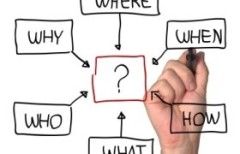Presentation skill is a broader topic than you might think. It goes beyond content expertise, slide design, stage presence, etc, to include how to prepare an effective presentation. Battles are won or lost before they start, and the same can be said about presentations.
It can also be said that everyone prepares their own way, except that there is a limited number of options when it comes to preparing a presentation.
So allowing for different approaches, what are the best practices for preparing a presentation—especially a presentation where there’s something at stake for the business, a project, or the presenter?
Best practices in preparing a presentation
Start with the end in mind: What do you want to accomplish with your presentation? What do you want your audience to know, feel, believe, or do? Remember, many important corporate presentations are designed to help an audience make a decision or a prediction. So a well-prepared presentation will take that fact into account.
Presentation preparation requires a limited number of messages
Then decide what points you will need to make in order to move your audience in the direction you would like them to go. If you need money to complete a project, remind them why it’s important to them that the project be completed successfully.
Presentation points should be benefits
And that’s another thing. Try to make your points benefits to the audience. Don’t just say, “We need further funding for the following three reasons: 1. We underestimated the cost. 2. Prices have gone up, and 3. Our competitors are hot on our heels so we need to pay for a rush job.”
Much better to say, “We need further funding so that: 1. We can launch at the peak of the market. 2. Boost our revenues and 3. Lower time to ROI by 3 years.”
Presentation points require proof
And once you know what points you need to make, then you must develop your evidence, or proof, to demonstrate that your points are true and valid, and will lead to beneficial outcomes. Proof often takes the form of data, facts, reasoning, and stories. Stories can be dismissed as anecdotal evidence, but they serve to paint a picture for your listeners and appeal to their emotions, which is an important thing to do.
Acknowledge, then refute, other ideas
Now, for the more advanced presenter, you may want to demonstrate to your audience that other people have different points of view than you do. Preparing a presentation means that you should be familiar with other approaches and other ideas. Go ahead and mention them if you like, because it gives you an opportunity to point out the liabilities of those other ideas, and stress the benefits of your own.
Presentations should argue psychologically, not logically
Which reminds me that speakers need to be thinking not logically, but psychologically. In other words, they need to know the peculiarities of the audience, their pet passions and pet peeves, in order to frame their arguments in a way that will appeal to the individuals addressed.
For instance, I worked with an engineering firm to help them win a major infrastructure project. We learned that one of the decision makers was a city councilman who loved light rail. We made sure to say that our design of the new waterfront would include a light rail line linking the old parts of the city to the new waterfront. And we demonstrated we could pay for it through our efficiencies in other areas. It worked.
Presentation openings and closings are important
Finally, to prepare a winning presentation, you need to prepare an opening and an ending. Both elements are extremely important. I suggest you make the opening all about them—your audience. Speak about their situation, their problems, their desires and aspirations, and then offer your content as something that will help them get what they want. Don’t make your presentation all about you. Make it all about them.
As for the ending, I suggest you circle back to your opening. Remind them of their situation, the problems that bedevil them, and the opportunities that lie ahead if only they could resolve the challenges they face. Then remind them of your main points.
However, instead of using the exact same language that you used at the start, use slightly different words. New words will peek their interest better, and help your messages sink in.
And don’t forget at the end to tell them what you want them to know, feel, think, believe and DO!
These are the basic elements of presentation preparation: a strategy to accomplish something; messaging; proof that your points are valid and true; and of course a good opening and an effective ending.
The last step of presentation preparation: PowerPoint
Then you need to create your slides. Notice that I am telling you that AT THE END of your presentation preparation process, you should create your slides. I am telling you that because they are the last thing that you should create, not the first. When preparing a presentation, first you create your logic (or your psycho-logic) and then you create your slides.
Here ends the lesson of the well-prepared presentation.
Sims Wyeth & Co. provides public speaking courses, leadership skills, presentation skills, voice training, speech training, speech writing, and courses that address stage fright, body language, presentation strategy, persuasive speaking, sales training, and effective use of PowerPoint, all of which contribute to greater executive presence and personal impact.
